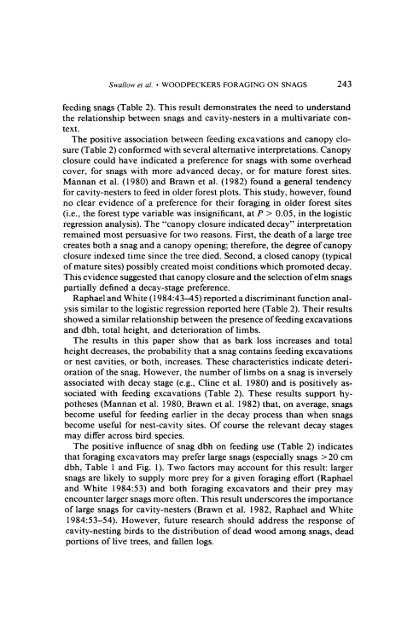Swallow, S. K., R. A. Howard, Jr., and R. J. Gutiérrez. 1988. Snag ...
Swallow, S. K., R. A. Howard, Jr., and R. J. Gutiérrez. 1988. Snag ...
Swallow, S. K., R. A. Howard, Jr., and R. J. Gutiérrez. 1988. Snag ...
Create successful ePaper yourself
Turn your PDF publications into a flip-book with our unique Google optimized e-Paper software.
<strong>Swallow</strong> et al. * WOODPECKERS FORAGING ON SNAGS 243feeding snags (Table 2). This result demonstrates the need to underst<strong>and</strong>the relationship between snags <strong>and</strong> cavity-nesters in a multivariate context.The positive association between feeding excavations <strong>and</strong> canopy closure(Table 2) conformed with several alternative interpretations. Canopyclosure could have indicated a preference for snags with some overheadcover, for snags with more advanced decay, or for mature forest sites.Mannan et al. (1980) <strong>and</strong> Brawn et al. (1982) found a general tendencyfor cavity-nesters to feed in older forest plots. This study, however, foundno clear evidence of a preference for their foraging in older forest sites(i.e., the forest type variable was insignificant, at P > 0.05, in the logisticregression analysis). The "canopy closure indicated decay" interpretationremained most persuasive for two reasons. First, the death of a large treecreates both a snag <strong>and</strong> a canopy opening; therefore, the degree of canopyclosure indexed time since the tree died. Second, a closed canopy (typicalof mature sites) possibly created moist conditions which promoted decay.This evidence suggested that canopy closure <strong>and</strong> the selection of elm snagspartially defined a decay-stage preference.Raphael <strong>and</strong> White (I1984:43-45) reported a discriminant function analysissimilar to the logistic regression reported here (Table 2). Their resultsshowed a similar relationship between the presence of feeding excavations<strong>and</strong> dbh, total height, <strong>and</strong> deterioration of limbs.The results in this paper show that as bark loss increases <strong>and</strong> totalheight decreases, the probability that a snag contains feeding excavationsor nest cavities, or both, increases. These characteristics indicate deteriorationof the snag. However, the number of limbs on a snag is inverselyassociated with decay stage (e.g., Cline et al. 1980) <strong>and</strong> is positively associatedwith feeding excavations (Table 2). These results support hypotheses(Mannan et al. 1980, Brawn et al. 1982) that, on average, snagsbecome useful for feeding earlier in the decay process than when snagsbecome useful for nest-cavity sites. Of course the relevant decay stagesmay differ across bird species.The positive influence of snag dbh on feeding use (Table 2) indicatesthat foraging excavators may prefer large snags (especially snags >20 cmdbh, Table 1 <strong>and</strong> Fig. 1). Two factors may account for this result: largersnags are likely to supply more prey for a given foraging effort (Raphael<strong>and</strong> White 1984:53) <strong>and</strong> both foraging excavators <strong>and</strong> their prey mayencounter larger snags more often. This result underscores the importanceof large snags for cavity-nesters (Brawn et al. 1982, Raphael <strong>and</strong> White1984:53-54). However, future research should address the response ofcavity-nesting birds to the distribution of dead wood among snags, deadportions of live trees, <strong>and</strong> fallen logs.
















